Conflict Zones
Harvard’s $2.3bn gamble: What Trump demanded; how the university resisted | Donald Trump News
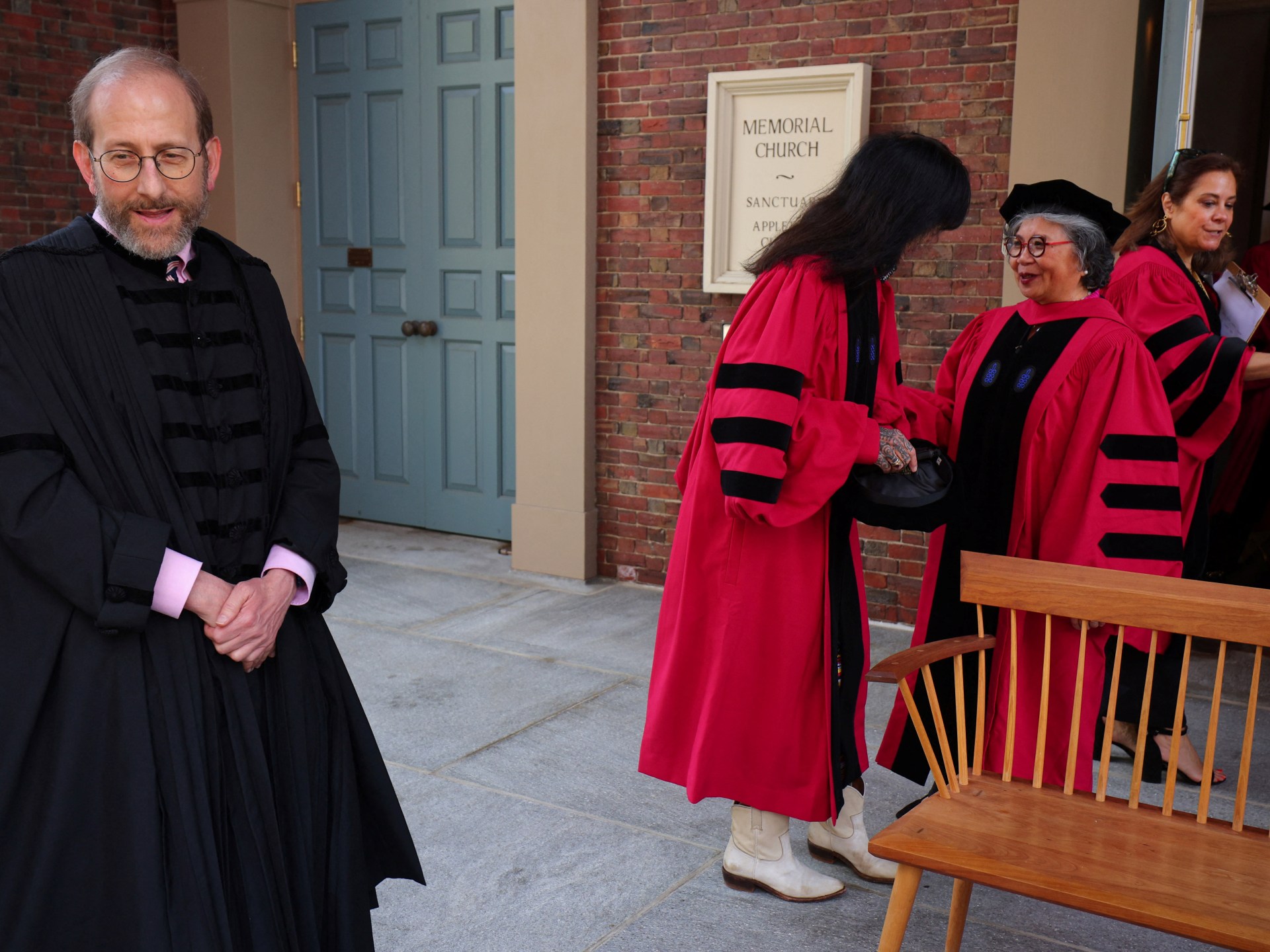
United States President Donald Trump’s campaign to pressure universities into dropping diversity, equity and inclusion measures and punishing student protesters has faced its strongest pushback yet when Harvard University rejected a series of demands from his administration.
Monday’s decision quickly prompted the US Department of Education to freeze nearly $2.3bn in federal funding for the Ivy League institution ranked among the best universities in the US.
In a response on his Truth Social platform on Tuesday morning, Trump accused Harvard of pushing “political, ideological, and terrorist inspired” notions rather than acting in the public interest.
So what happened between Harvard and Trump, and why did the institution risk billions of dollars to go against the administration’s demands?
What did the Trump administration ask Harvard to do?
The heads of the US Department of Education, Department of Health and Human Services, and the General Services Administration co-signed a letter to Harvard on Friday. In this letter, they claimed “Harvard has in recent years failed to live up to both the intellectual and civil rights conditions that justify federal investment.”
This was followed by a list of demands for the university in Cambridge, Massachusetts, to fulfil. Key among them were:
Promoting faculty committed to the Trump administration’s demands of Harvard, as articulated in the letter, and “reducing the power” of faculty and administrators “more committed to activism than scholarship”.
Ending all affirmative action in faculty hiring and student admissions by August. At the same time, the letter demanded that the university ensure “viewpoint diversity” by abolishing criteria during admissions and hiring processes “that function as ideological litmus tests”.
Changing the admissions process “to prevent admitting international students hostile to the American values”, including “students supportive of terrorism or anti-Semitism”. The letter did not define what it meant by “American values”. For the 2024-2025 academic year, there were 6,793 international students at Harvard, making up 27.2 percent of its total enrolment – up from less than 20 percent in 2006-2007.
Changing disciplinary policies and forbidding the recognition and funding of student groups or clubs that promote “criminal activity, illegal violence, or illegal harassment”.
Implementing a comprehensive mask ban with immediate, serious penalties for violation “not less than suspension” after some students have protested while wearing masks. The letter did not list any exceptions to this rule, such as health reasons.
Closing all diversity, equity, and inclusion (DEI) programmes and offices and carrying out organisational reform to ensure transparency with federal regulators.
Harvard was given a deadline of August to implement these changes. This is the second letter issued by the Trump administration to Harvard. The first one was issued on April 3 and called on Harvard to ban face masks and reform academic departments that it alleged were guilty of anti-Semitic bias. Charges of anti-Semitism have been levelled against numerous US universities and colleges since widespread campus protests were held against the war in Gaza.
How did Harvard respond to the demands?
Harvard’s lawyers responded to the Trump administration by saying the university rejected the demands, arguing they violated its First Amendment rights and freedoms recognised by the US Supreme Court. The US Constitution’s First Amendment upholds the rights to free speech, expression and assembly.
The university said Harvard strongly opposes anti-Semitism and continues to make structural changes to ensure that the institution is a welcoming and supportive learning environment for all students.
The university also published a separate letter online signed by President Alan Garber on Monday. In the letter, Garber said federal grants have led to research and innovation in fields pertaining to science and medicine. “These innovations have made countless people in our country and throughout the world healthier and safer,” he wrote.
The letter then referred to how the government had threatened to pull federal funding from several universities, including Harvard, over allegations of anti-Semitism on campus. The letter said the government retreating from its funding agreements with higher education institutions “risks not only the health and well-being of millions of individuals but also the economic security and vitality of our nation”.
The Harvard letter said that while some of the government’s demands are aimed at combating anti-Semitism, “the majority represent direct governmental regulation of the ‘intellectual conditions’ at Harvard.”
“The University will not surrender its independence or relinquish its constitutional rights,” Garber added.
The Harvard chapter of the American Association of University Professors filed a lawsuit on Friday in a federal court in Boston, accusing the Trump administration of “unlawful and unprecedented misuse of federal funding and civil rights enforcement authority to undermine academic freedom and free speech on a university campus”.
In his latest online post, Trump wrote, “perhaps Harvard should lose its Tax Exempt Status and be Taxed as a Political Entity if it keeps pushing political, ideological, and terrorist inspired/supporting ‘Sickness?’ Remember, Tax Exempt Status is totally contingent on acting in the PUBLIC INTEREST!”
What is the backdrop to this standoff?
In January 2024, Garber had set up presidential task forces on campus to combat anti-Semitism and fight bias against Muslims and Arabs as Israel’s war on Gaza raged, igniting tensions on campuses around the world, including in the US.
In April 2024, pro-Palestine protesters set up an encampment on the Harvard campus, called Harvard Out of Occupied Palestine (HOOP). The protesters demanded that Harvard divest from weapons companies and companies associated with Israel.
At that time, Garber said HOOP had disrupted educational activities on campus. In May, the university and protesters said they had reached an agreement to end the encampment, but the two parties gave different accounts about the terms of this agreement.
While the student protesters said Harvard had agreed to their demands, the university said it had only opened itself to dialogue on the demands. For example, pertaining to the students’ demand for the university to divest from companies with ties to Israel, Harvard said it had agreed to be more transparent with its students about how its endowment works.
How much federal funding could Harvard lose?
On Monday, hours after Harvard’s response, a task force created by the US Department of Education to tackle anti-Semitism released a statement announcing that $2.3bn in federal funding to the university had been frozen.
“Harvard’s statement today reinforces the troubling entitlement mindset that is endemic in our nation’s most prestigious universities and colleges – that federal investment does not come with the responsibility to uphold civil rights laws,” the statement said. The frozen federal funds to Harvard include $2.2bn in grants and $60m in contracts, the statement added.
However, more money is at stake – about $9bn. On March 31, the Education Department, Department of Health and Human Services and the General Services Administration released a statement warning they would review $255.6m in contracts between the federal government and Harvard and its affiliates. The statement added that they would also review more than $8.7bn in multiyear grant commitments to Harvard and its affiliates.
Harvard’s endowment amounted to $53.2bn in the 2024 fiscal year — the largest of any university. However, donors decide which programmes, departments and purposes 70 percent of the annual endowment distribution is spent on. Endowment donations also dropped by $151m in 2024 as several billionaire donors stopped funding the institution over its response to concerns over anti-Semitism on campus, the university’s student-run newspaper, the Harvard Crimson, reported in October.
How have things unfolded at other US universities?
While Harvard is the first university to reject the Trump administration’s demands, it is not the first Ivy League school to be targeted.
Last year, Columbia University in New York emerged as the epicentre of pro-Palestine campus protests. Protesters occupied a campus building, Hamilton Hall, on April 30. The university called in the New York Police Department to crack down on student protesters.
In February, the Trump administration pulled back Columbia’s federal funding, worth $400m, citing the institution’s “failure to protect Jewish students from anti-Semitic harassment”. In March, Immigration and Customs Enforcement (ICE) agents arrested Mahmoud Khalil, a recent Columbia graduate and protest leader who had negotiated with the university during the campus demonstrations. Days earlier, the US Department of State revoked the visa of Ranjani Srinivasan, who was an urban planning doctoral candidate at Columbia. Soon after, Columbia unenrolled Srinivasan, who flew to Canada before she could be deported.
On March 13, the government’s Joint Task Force to Combat Anti-Semitism issued a letter to Columbia with nine demands for negotiations to restore the funding that was pulled. On March 18, Columbia accepted the government’s demands, listed in a new memo. The memo said protesting students will have to present university identification if prompted. It added that face masks would be banned if they are being used to conceal a person’s identity. However, face coverings are still allowed for religious or medical reasons. The memo also added that Columbia had hired 36 security officers who have special powers to arrest students, and the university continues to rely on New York police for additional security assistance.
Over the past few weeks, the Trump administration has suspended or frozen funding for Princeton, Cornell and Northwestern universities. The universities have responded by expressing frustration and highlighting how federal funding is important for critical research.
On April 11, the US Department of Energy, which funds research at many universities, announced a universal cap on the indirect costs it would finance for projects it supports. The agency said this would save the government $405m a year.
Nine universities and three bodies representing higher education institutions have since filed a lawsuit challenging that cap. The plaintiffs in the case include the Association of American Universities, American Council on Education, Association of Public and Land-Grant Universities, Brown University, California Institute of Technology, Cornell University, Board of Trustees of the University of Illinois, Massachusetts Institute of Technology, the regents of the University of Michigan, Board of Trustees of Michigan State University, the trustees of Princeton University and the University of Rochester.
What are the reactions to Harvard’s dispute with Trump?
Vermont Senator Bernie Sanders congratulated Harvard on X on Monday “for refusing to relinquish its constitutional rights to Trump’s authoritarianism”.
Congratulations to Harvard for refusing to relinquish its constitutional rights to Trump’s authoritarianism.
Other universities should follow their lead.
And instead of doing pro bono work for Trump, cowardly law firms should be defending those who believe in the rule of law.
— Bernie Sanders (@BernieSanders) April 14, 2025
Former US President Barack Obama posted on Tuesday: “Harvard has set an example for other higher-ed institutions – rejecting an unlawful and ham-handed attempt to stifle academic freedom.”
Harvard has set an example for other higher-ed institutions – rejecting an unlawful and ham-handed attempt to stifle academic freedom, while taking concrete steps to make sure all students at Harvard can benefit from an environment of intellectual inquiry, rigorous debate and… https://t.co/gAu9UUqgjF
— Barack Obama (@BarackObama) April 15, 2025
Massachusetts Governor Maura Healey posted a statement on X congratulating Harvard for “standing against the Trump Administration’s brazen attempt to bully schools and weaponize the US Department of Justice under the false pretext of civil rights”.
My statement on @Harvard’s response to demands from the Trump Administration. pic.twitter.com/IYa7LSG7iX
— Maura Healey (@MassGovernor) April 14, 2025
Conflict Zones
Trump says US may ‘pass’ on helping end war if Russia, Ukraine resist deal | Russia-Ukraine war News
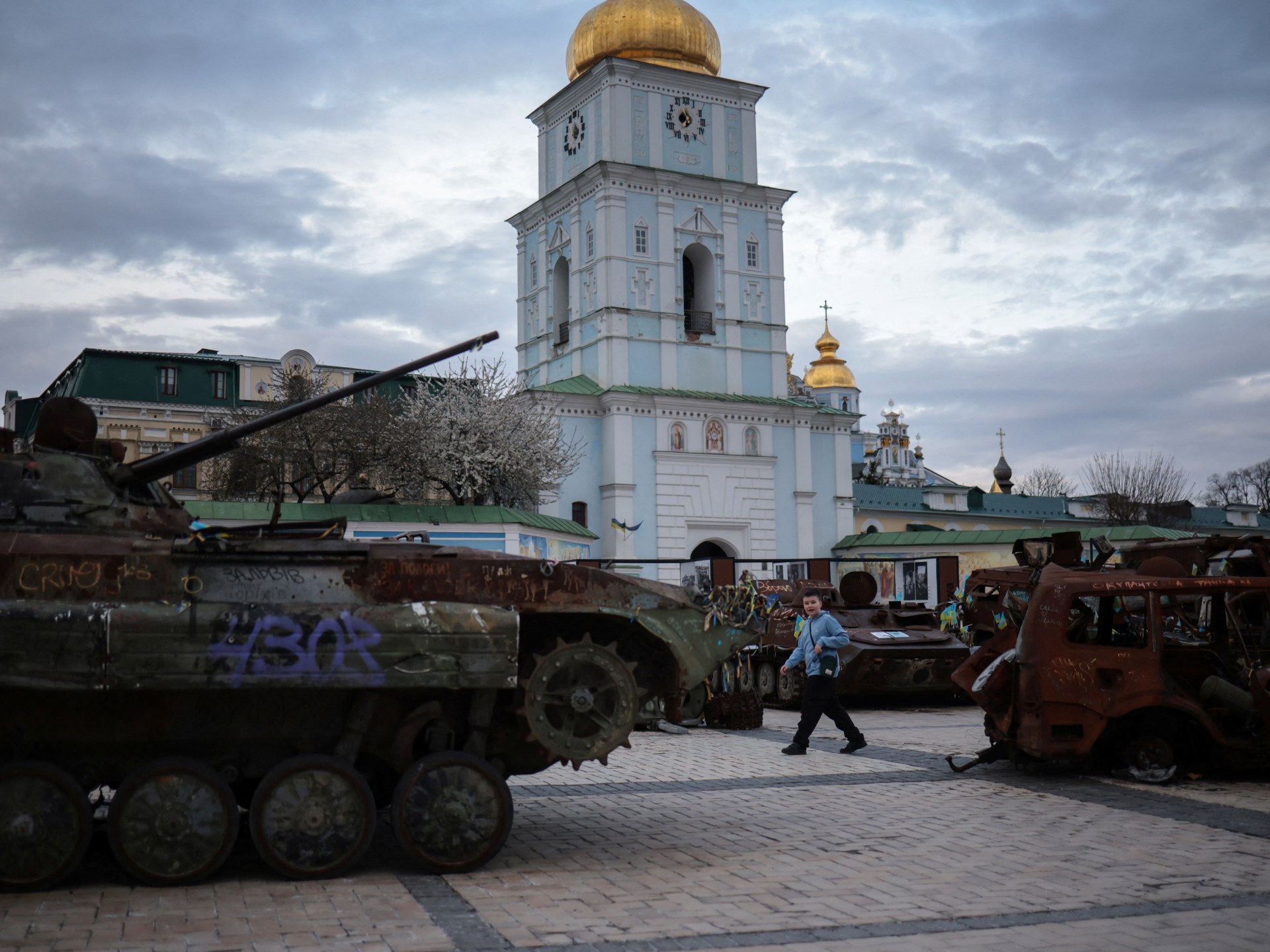
President Donald Trump says the United States will “take a pass” on trying to resolve the Russia-Ukraine war if either Moscow or Kyiv makes it too difficult to end the conflict.
Trump was speaking after US Secretary of State Marco Rubio commented – following talks with European allies in Paris – that Washington would “move on” if a truce did not seem “doable” within days.
The US president refused on Friday to cast blame on either Russian President Vladimir Putin, who ordered the February 2022 full-scale invasion of pro-Western Ukraine, or Ukrainian President Volodymyr Zelenskyy. But he insisted both sides had to make progress.
“Now, if, for some reason, one of the two parties makes it very difficult, we’re just going to say: ‘You’re foolish. You’re fools. You’re horrible people’ – and we’re going to just take a pass,” Trump said.
“But, hopefully, we won’t have to do that.”
Rubio further suggested on Friday that Trump’s patience towards the negotiations is running thin.
“If it’s not possible, if we’re so far apart that this is not going to happen, then I think the president is probably at a point where he’s going to say, ‘Well, we’re done,’” he said.
Trump told reporters on Friday, however, that he did not want to say he was walking away from the talks. He said he still believes there is a good chance to end the conflict.
“It’s coming to a head right now,” he said.
US Vice President JD Vance also said he was “optimistic” a resolution could be reached, while speaking on a trip to Rome.
‘Trying to help’
Ukraine has agreed to a full temporary ceasefire and accused Russia of stalling on a deal to get a better negotiating position.
Putin last month rejected a joint US-Ukrainian proposal for a full and unconditional pause in the conflict, while the Kremlin has made a truce in the Black Sea conditional on the West lifting certain sanctions.
When asked if Putin was stalling, Trump, who held direct talks with the Russian leader in February, said: “I hope not … I’ll let you know soon.”
Trump also denied he was being “played” by the former KGB agent, who denied Russia was going to invade right up until the eve of the attack.
“Nobody’s playing me, I’m trying to help,” Trump said.
Russia’s Foreign Minister Sergey Lavrov said in an interview with the Kommersant newspaper published on Monday that it is “not easy” to agree on “key components” of a peace deal.
He did, however, concede that the Trump administration is trying to understand the “root cause” of the conflict, which he said was triggered by “the actions of Washington and Brussels” in having “brought the current regime to power in Ukraine”.
Fighting continues
Amid ceasefire negotiations, on the front line on Friday, a Russian missile strike killed one person in the northeastern Ukrainian city of Kharkiv, with a separate drone attack killing another person in the nearby city of Sumy.
At least five children were among dozens of people injured in Friday morning’s attack on Kharkiv that damaged 15 residential buildings, a business and an educational facility, according to Kharkiv Mayor Ihor Terekhov and emergency services.
Reporting from Kyiv, Al Jazeera’s Zein Basravi said Russia also targeted Lviv, Dnipro, Mykolaiv and Kyiv.
“We saw multiple missile, drone, artillery and rocket attacks in cities across the country about 5am local time when curfews come to a close and people begin their daily lives,” he said.
“[In Kharkiv], civilian infrastructure was damaged, one person was killed, and 74 were injured. Of the 74, five were children,” Basravi reported.
President Zelenskyy said on Thursday that although Russia had seemingly scaled back its targeting of energy infrastructure, the overall volume of missile and drone attacks remained unchanged. It is striking Ukraine’s civilian sites instead, he added.
Russia has said it had hit “key drone production sites” and Ukrainian military airfields.
Moscow also warned on Friday of potential escalation if Germany proceeds with plans to send Taurus long-range missiles to Ukraine. Speaking at the United Nations on Thursday, Russia’s ambassador, Vassily Nebenzia, declared that such a move would mark Germany’s direct entry into the war.
“These countries are waging a war against Russia using their proxy forces,” he said. “Delivering Taurus missiles would be another step toward escalation.”
Conflict Zones
‘How do I live like this?’ asks Gaza boy who lost arms in Israeli attack | Gaza News
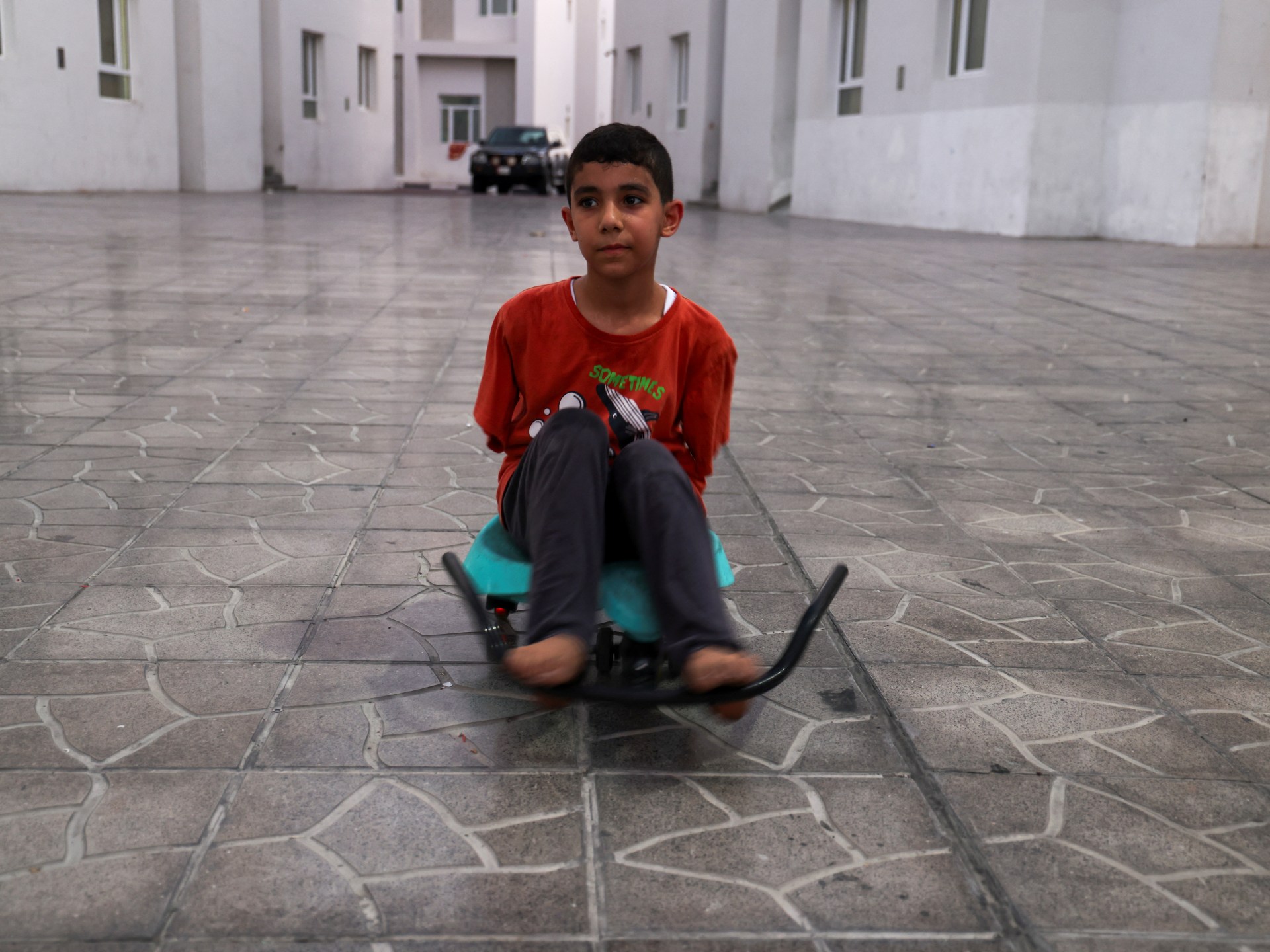
An image of Mahmoud Ajjour, 9, who was severely wounded in an Israeli strike, won the 2025 World Press Photo of the Year award.
A Palestinian child who was severely wounded in an Israeli drone attack on Gaza last year, and who was pictured in an image that won the 2025 World Press Photo of the Year award, says he has been struggling to adapt to life since losing both his arms in the explosion.
Speaking to Al Jazeera from Doha, Qatar, where he has been receiving treatment, nine-year-old Mahmoud Ajjour recalled the moment the bomb exploded, targeting his home in March 2024.
At first, Ajjour, who hails from Gaza City’s old town, said he did not realise he was wounded.
“I thought I had simply fallen. But I found myself on the ground, exhausted, and wondering what had happened,” he told Al Jazeera.
In reality, one arm “flew off, and one flew and fell right beside me”, he added.
Still unaware that he had sustained serious wounds – wounds that mutilated his entire body – Ajjour said he looked around and saw his arms. Although they looked familiar, his brain still could not comprehend that they had been blown off.
“My mother then told me that I lost my arms,” Ajjour recalled. “I started crying. I was very sad, and my mental state was very bad.”
His mental health deteriorated further when he, like many others in Gaza, had to undergo surgery without anaesthetics due to a severe lack of medical supplies. Throughout the war, Israeli forces have largely kept vital border crossings shut, preventing the entry of much-needed medical supplies, as well as food and other aid, including fuel.
“They performed surgery on me while I was awake,” Ajjour said, the shock still evident in his voice.
“I couldn’t bear the pain, I was screaming very loud. My voice filled the hallways.”
‘Everything is difficult’
Ajjour is one of thousands of children in Gaza who are suffering life-changing injuries due to relentless, indiscriminate Israeli bombardment.
According to the United Nations Children’s Fund, more than 10 children each day have lost one or both of their legs since October 7, 2023, when Israel launched its ongoing genocide in Gaza.
That is more than 1,000 children.
“Gaza now has the highest number of children amputees per capita anywhere in the world – many losing limbs and undergoing surgeries without even anaesthesia,” UN Secretary-General Antonio Guterres said in December.
Ajjour is now learning to write, play games on his phone, and dress himself using his feet – but still needs special assistance for most daily activities.

He now longs for the days when his arms were still intact.
Before the attack, Ajjour said he used to go to the market and buy his mother vegetables and food she needed.
“Now, everything is difficult, including feeding myself, helping myself to the bathroom … but I try my best,” he said. “I manage my life like this. I make it work.”
Ajjour dreams of a future where he can return to Gaza and help rebuild the devastated enclave.
He hopes the world can “end the war on Gaza”.
“We want to live on our land. We don’t want the Israelis to take it,” he said.
“People are dying there [in Gaza]. And my home was bombed. How could I live like this?”
Israel’s ongoing assault on the besieged and bombarded territory has so far killed more than 51,000 Palestinians and wounded at least 116,505 others, according to Gaza’s Ministry of Health.
It has also forcibly displaced most of its 2.3 million strong population, ravaged most of the land, damaged basic infrastructure and dismantled its already-struggling healthcare system.
Conflict Zones
Iran has ‘doubts’ about US intentions ahead of nuclear talks | Politics News
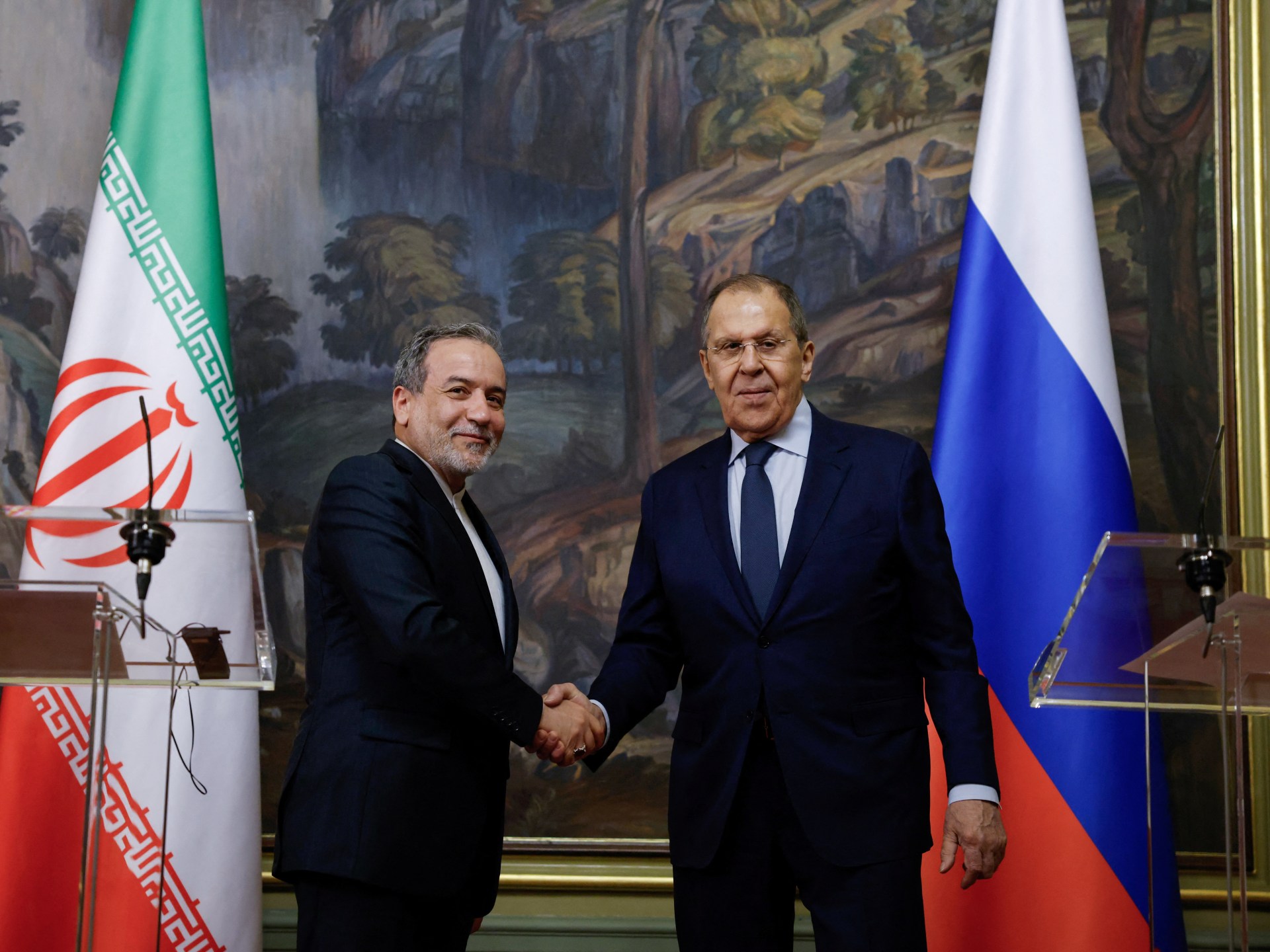
Iran’s Foreign Minister Abbas Araghchi has cast doubt over the intentions of the United States a day before a second round of nuclear talks is set to take place with Washington.
The new round will come a week after the two countries held their highest-level negotiations since US President Donald Trump unilaterally abandoned a 2015 landmark nuclear deal three years later. Iran has since abandoned all limits on its nuclear programme, and enriches uranium to up to 60 percent purity – near weapons-grade levels of 90 percent.
“Although we have serious doubts about the intentions and motivations of the American side, in any case, we will participate in tomorrow’s negotiations,” Araghchi said on Friday during a news conference in Moscow with his Russian counterpart, Sergey Lavrov.
Araghchi will set off on Saturday for Rome for a new round of Omani-mediated talks with US Middle East envoy Steve Witkoff.
“We are fully prepared to pursue a peaceful resolution for Iran’s peaceful nuclear programme,” Araghchi said.
Lavrov said Moscow was ready “to play any role that will be useful from Iran’s point of view and that will be acceptable to the United States”.

Russia, which commands the world’s largest confirmed arsenal of nuclear weapons, has deepened its military ties with Iran since it launched its offensive on Ukraine in February 2022, and has played a role in Iran’s nuclear negotiations in the past as a veto-wielding United Nations Security Council member.
Western countries, including the US, have long accused Iran of seeking to acquire nuclear weapons – an allegation Tehran has consistently denied, insisting that its programme is for peaceful civilian purposes.
Al Jazeera’s Tohid Asadi, reporting from Tehran, said there is “a cloud of mistrust in the air” despite statements made by Araghchi.
“With the talks ahead, there is a perception among Iranians that there is this mistrust that exists pertaining to the United States, but going back to the statement that were heard today … we saw a mix of doubt and hope at the same time,” Asadi said.
“Iran is saying it is not interested in putting other issues … [such as] nuclear capabilities … on the table of negotiations,” he added.
‘Unrealistic demands’
US President Donald Trump has threatened to attack Iran if it does not agree to a deal with the US.
On Tuesday, Iran’s Islamic Revolutionary Guard Corps said the country’s military capabilities were off limits in the discussions.
The official IRNA news agency reported Iran’s regional influence and its missile capabilities, long criticised by Western governments, were among its “red lines” in the talks.
On Wednesday, the Iranian foreign minister said Iran’s enrichment of uranium was not up for discussion, after Witkoff called for it to end.
“If there is similar willingness on the other side, and they refrain from making unreasonable and unrealistic demands, I believe reaching an agreement is likely,” Araghchi said during Friday’s news conference.
Lavrov emphasised that any potential agreement should only pertain to the nuclear issue.
“This is a fundamental point that must be taken into account by those who try to burden the negotiations with non-nuclear issues and thus create a very risky situation,” he said.
Iran told the US during last week’s talks it was ready to accept some limits on its uranium enrichment, but needed watertight guarantees Trump would not again ditch the pact, an Iranian official told the Reuters news agency on Friday, speaking on condition of anonymity.
The official said Tehran’s red lines “mandated by Supreme Leader Ayatollah Ali Khamenei” could not be compromised in the talks, adding that those red lines meant Iran would never agree to dismantle its centrifuges for enriching uranium, halt enrichment altogether, or reduce the amount of enriched uranium it stores to a level below the level it agreed in the 2015 deal.
It would also not negotiate over its missile programme, which Tehran views as outside the scope of any nuclear deal, Reuters reported.
US Secretary of State Marco Rubio said earlier on Friday that the US administration is looking for a peaceful solution with Iran but will never tolerate the country developing a nuclear weapon.
Rubio met with British, French and German officials in Paris and pressed them to maintain sanctions against Iran instead of allowing them to run out.
Israel also reiterated its unwavering commitment to preventing Iran from obtaining nuclear weapons, saying it had a “clear course of action” to prevent this.
“Prime Minister Benjamin Netanyahu and I, along with all relevant bodies, are committed to leading a clear course of action that will prevent Iran from acquiring nuclear weapons,” Defence Minister Israel Katz said on Friday.
-

 Conflict Zones1 day ago
Conflict Zones1 day agoHaiti in ‘free fall’ as violence escalates, rights group warns | Armed Groups News
-

 Africa2 days ago
Africa2 days agoRobot waiter becomes a star attraction at Havana restaurant
-

 Sports2 days ago
Sports2 days agoDagestan: Why this region of Russia produces so many MMA champions
-
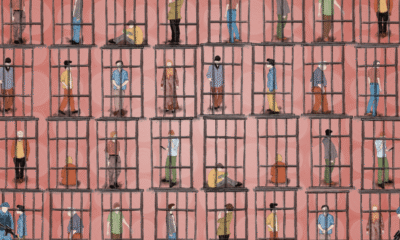
 Conflict Zones2 days ago
Conflict Zones2 days agoA nation behind bars: Why has Israel imprisoned 10,000 Palestinians? | Israel-Palestine conflict News
-

 Sports2 days ago
Sports2 days agoArsenal reaches first Champions League semifinal in 16 years, with Inter Milan also advancing
-

 Sports1 day ago
Sports1 day agoJu Wenjun: Chinese grandmaster makes history by winning fifth Women’s World Chess Championship
-

 Sports1 day ago
Sports1 day agoAaron Boupendza: 28-year-old former MLS player dies after falling from 11th floor balcony in China
-

 Lifestyle1 day ago
Lifestyle1 day agoRalph Lauren stays closer to home this time with intimate Manhattan gallery show




